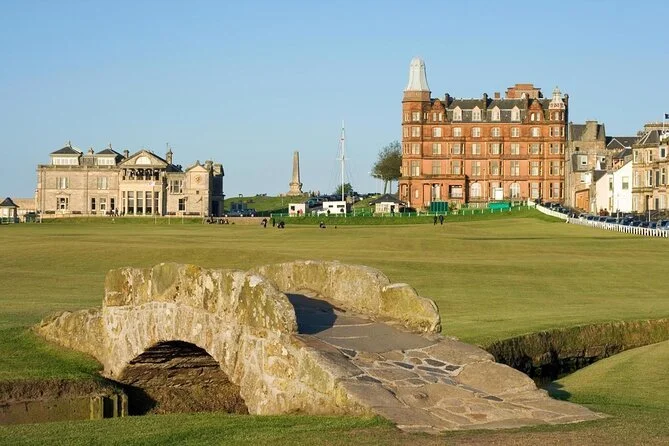Crystal Downs
Crystal Downs
It was 1983 when 72 year old golf course architect Geoffrey Cornish said to me “Crystal Downs.” I wanted to know a golf course he considered great, that I had never heard of. It took me 40 years to get there. He was not wrong.
Crystal Downs, designed by Alister MacKenzie and assisted by Perry Maxwell in 1927, it is one of the top courses I have ever played. The Alister MacKenzie Society, a group of Mackenzie afficinados rate Crystal Downs, Cypress Point, Royal Melbourne, and Augusta National as his best work.
High praise when some of his other courses include the highly rated Valley Club of Montecito, Kingston Heath in Australia, and Lahinch in Ireland.
Crystal Downs is 40 minutes west of Traverse City in the far north of Michigan in Frankfort. It’s in cherry country in the north of the state, home to many wonderful courses. Arcadia Bluffs Golf Club, another top 100 course is about ten minutes away. If Northern Michigan was a more accessible, all of the courses would be better known. It’s not a part of the country you think about when planning a golf trip.
The drive from Traverse City passes though small villages economically supported by summer visitors. Trees form a covered hallway on the winding road to the town of Frankfort. It’s a picture post card village with a drive in movie screen on the outskirts of town. It’s a throw back where generations of summer inhabitants come each summer, their roots deep in the past.
“My wife’s family started coming up here in 1948,” said a summer resident. “We have been married for 41 years and haven’t missed a year. Now my kids and grandkids come up.”
Until the mid 1980s the course was largely unknown to all but locals. Then top golf course architect Tom Doak, a Crystal Downs member, brought Ben Crenshaw up to see it. Ben raved about it. In 1991 Crystal Downs hosted the USGA Senior Amateur and the word was out. It was no longer a secret.
Before 1990 Crystal Downs was not listed in the Golf Digest Top 100 Courses in America. In the years after 1991 it climbed as high as fourteen.
If there were more course raters seeing the course it might be higher than it’s current spot at number twenty.
While there are no holes on the lake, it is visible from some spots. The course is surrounded by heavily forested areas on the surrounding hills, reaching up from the golf course below. With leaves changing color on my fall visit, to deep red, bright yellow and muted oranges, it’s a beautiful setting.
The soil is sand, providing the fantastic bumps and rolls on the fairways formed by thousands of years of wind and water. As with most courses designed by the classic architects, CB Macdonald, Seth Raynor and Donald Ross , the fairways are generous, and the bunkers dramatic.
However it’s the greens and the green complexes that separate Crystal Downs from all the rest. The greens are the most severe I have ever seen. Every one of them. They are large with shelves, slopes, sections, thumb prints, ridges, mounds and bumps.
The greens at Augusta National that Mackenzie built, are severely sloped, but nothing like Crystal Downs. If the speed of the greens is over 10.5 on the stempmeter, they become unplayable.
“I was in the club championship last year,” a Crystal Downs member told me. “We were both on on the par three, 11th hole. We walked off with a four putt and a five putt.”
Crystal Downs is the only course I have seen that does not have to worry about the continual push for higher green speeds. Higher green speeds would make the course unplayable for even PGA Tour players.
Keeping the ball under the hole is mandatory to keep from terror on the greens. There are positions behind the hole or to the side, on every green, where a player needs great skill to keep from putting off the front of the green or into a bunker. As for bunker shots, many times a player is just trying to keep the ball on the green, no matter where the hole is.
It sounds like it would not be fun, but it is just the opposite. It was more fun with each round.
In 2000 noted golf writer George Peper and the editors of Golf Magazine published a book, “The 500 World’s Greatest Golf Holes.” On the list of top 100 holes they selected two holes from Crystal Downs. No course had more. I might have nominated all 18. It’s that good.
MacKenzie wrote, “Every endeavor should be made to increase the strategy, variety, mystery, charm and elusiveness so that we shall never get bored.” There is no gettng bored at Crystal Downs. Every hole is unique to the course and a challenge.
“Depending on wind, and hole location MacKenzie had learned by studying St Andrews that alternative routes infuse intrigue to great holes,” wrote George Peper in his book. Crystal Downs is intriguing.
MacKenzie accomplished his goal a Crystal Downs time and again. The topography throughout is unique. Humps, bumps, rolls, sharp slops, Crystal Downs has it all in just under 6600 yards. However it plays much longer. A level lie is rare any where on the course.
Holes travel up and down slopes and hills. The first tee and tenth tee are high above the course below. It’s a stunning view. Of course teeing off 100 feet in the air means holes must come back up the same hill on other holes.
I commented about an interesting feature in a fairway to recently retired golf professional Fred Muller. “That’s the way it was, he didn’t move anything in the fairway.”
I was fortunate to play three rounds. Fun does not begin to describe playing Crystal Downs. Each round was more enjoyable than the last. The challenge of keeping the ball below the hole and putting on the greens makes every round a thrill.
A strategy, depending on the location of the hole, is to not hit the ball past the front edge of the green. Members intentionally hit the ball so as not to end up past the front of the green. They chip or putt the ball up to the hole, so as to avoid any chance of being past the hole.
I drove out of Crystal Downs past the Cherry Drive In-Theatre through now quiet summer retreat burgs and on to the Traverse City Cherry Capital Airport, reliving playing a great golf course.
There is no running out of fun and challenge at Crystal Downs. A well kept secret for many decades, Crystal Downs has been discovered. It’s Alister MacKenzie at his best and is one of my favorite courses in A Life In Golf.




